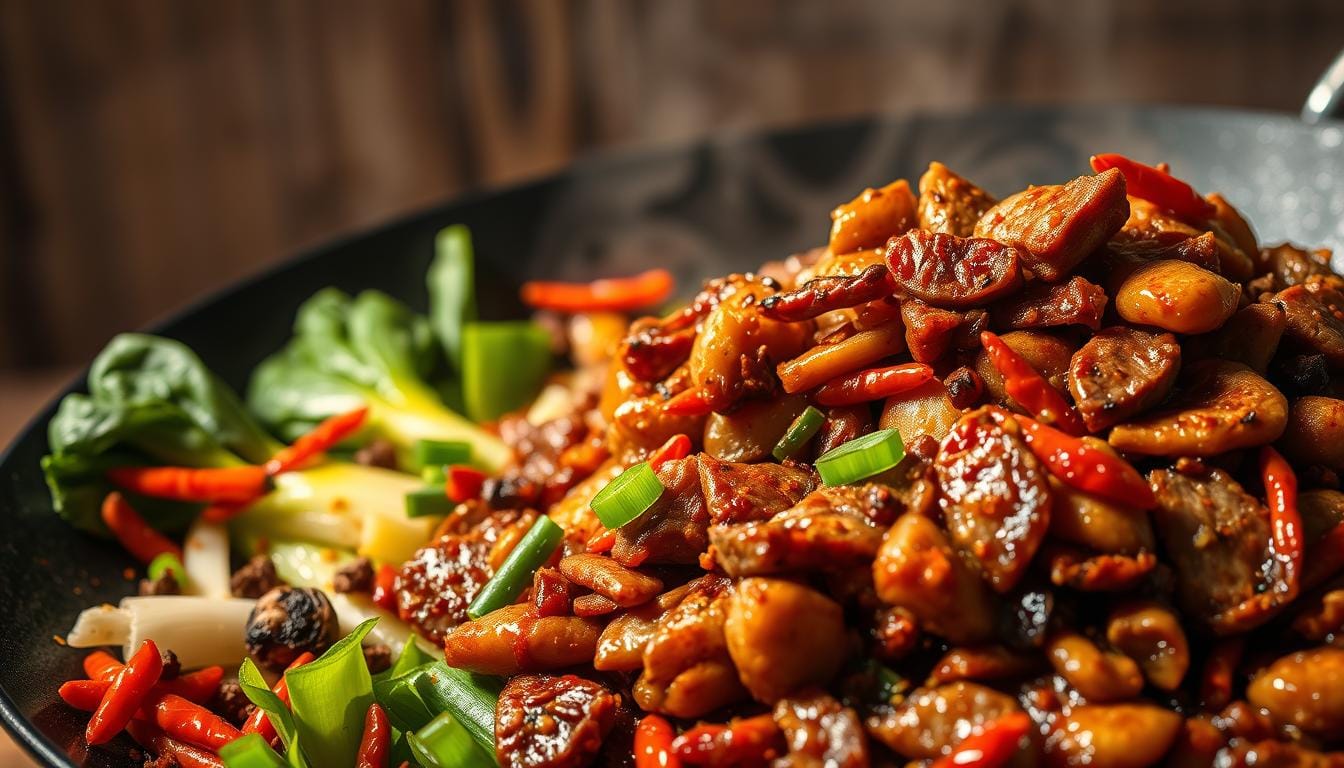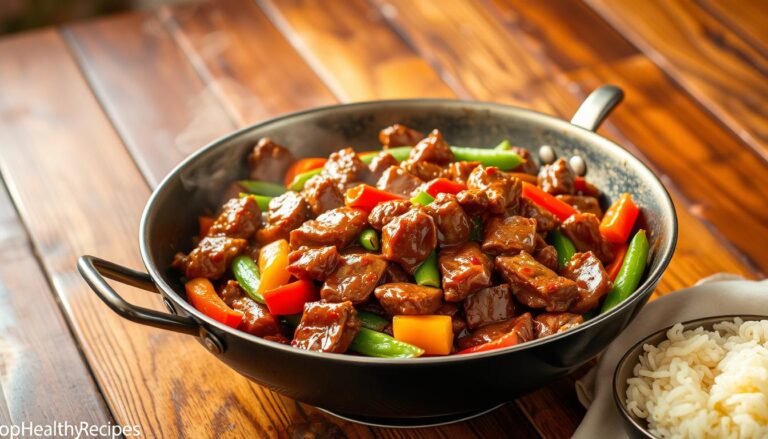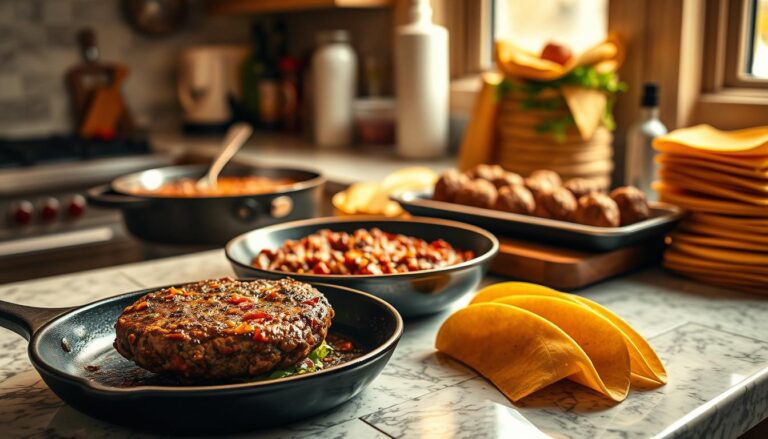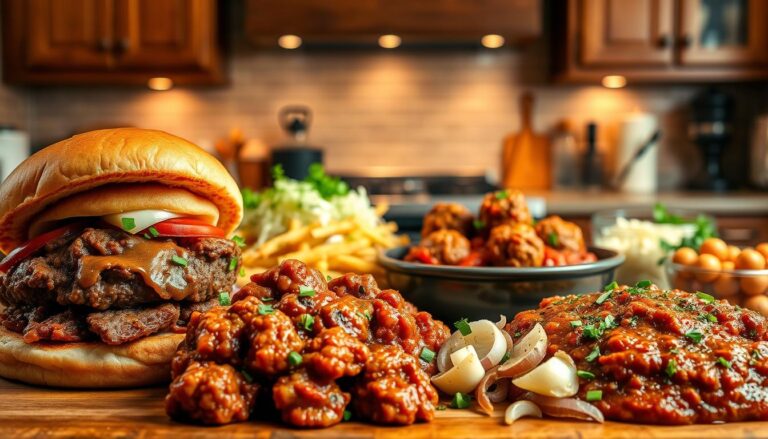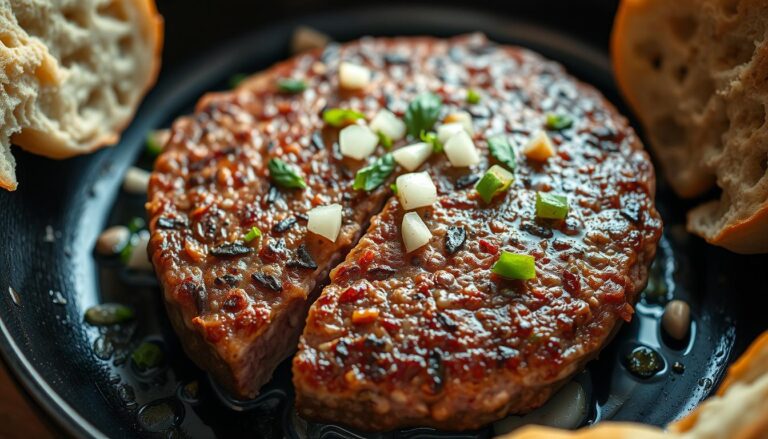Irresistible Szechuan Spicy Beef Recipe for Heat Lovers
Table of Contents
how to make szechuan beef Irresistible and Spicy for Heat Lovers
Imagine walking into a bustling Chinese restaurant. The smell of sizzling beef fills the air, making your mouth water. The first bite is like a journey to a world of bold flavors and numbing sensations.
Have you ever wondered what makes Szechuan cuisine so special? It’s the perfect mix of heat, flavor, and texture. This is what makes Szechuan spicy beef so unique.
Key Takeaways
- Discover the authentic techniques behind Szechuan spicy beef
- Learn about the essential ingredients that make this dish unique
- Understand the cultural significance of Szechuan cuisine
- Master the art of balancing heat and flavor in your cooking
- Create restaurant-quality Szechuan spicy beef at home
What is Szechuan Spicy Beef?
To understand Szechuan Spicy Beef, you need to know its roots in Szechuan cuisine. This dish comes from China’s Sichuan province. It’s known for its bold flavors and spicy dishes.
Origins of Szechuan Cuisine
Szechuan cuisine has a rich history, over 2,000 years old. It was shaped by the region’s geography and climate. The Sichuan basin, surrounded by mountains, has a unique culture and culinary tradition.
The use of local ingredients like Sichuan peppercorns, chilies, and garlic defines Szechuan dishes. The region’s position along the Silk Road also introduced various culinary influences.
Key Ingredients Used
Authentic Szechuan Spicy Beef uses key ingredients that set it apart from Americanized versions. The essential components include:
- Sichuan peppercorns: Known for their unique numbing effect.
- Doubanjiang (fermented broad bean paste): Adds depth and umami flavor.
- Various chilies: Contribute to the dish’s spiciness.
- Specific cuts of beef: Typically, tender cuts like sirloin or ribeye are used.
Flavor Profile Overview
The flavor profile of Szechuan Spicy Beef is complex. It balances ma (numbing) and la (spicy) sensations. The numbing effect comes from Sichuan peppercorns, while the spiciness is from various chilies.
Flavors from garlic, ginger, and doubanjiang add depth and complexity. This unique combination makes Szechuan Spicy Beef a standout in Szechuan cuisine.
The Heat Factor: Understanding Spiciness
The heat in Szechuan spicy beef comes from a mix of spices. This mix is what makes Szechuan dishes so bold and aromatic.
To get the heat right in Szechuan spicy beef, you need to know about spiciness. The Scoville Scale measures how spicy something is. It shows how much capsaicin is in a pepper or spice.
Scoville Scale Explained
The Scoville Scale shows the heat of a pepper or spice. It ranges from 0 SHU for sweet peppers to over 2 million SHU for the hottest. Capsaicin, the compound in spicy food, causes the ‘burning’ feeling.
| Pepper Type | Scoville Heat Units (SHU) |
|---|---|
| Sweet Pepper | 0 |
| Jalapeño | 2,500 – 8,000 |
| Szechuan Pepper | 0 (non-pungent, numbing) |
| Habanero | 100,000 – 350,000 |
Common Spices in Szechuan Cooking
Szechuan cooking uses many spices. These include Szechuan peppercorns, dried chili flakes, chili oil, and fermented pastes. Szechuan peppercorns are special because they numb instead of heat.
Dried chili flakes and chili oil add a lot of heat. The type and amount used can change how spicy a dish is.
- Szechuan peppercorns: Known for their numbing effect.
- Dried chili flakes: Adds intense heat.
- Chili oil: Infused oil that adds a spicy kick.
- Fermented pastes: Complex flavor enhancers that can add depth and heat.
Knowing how these spices work together is key to making great Szechuan spicy beef. You can adjust the heat to your liking by changing the spices used.
How to Prepare Szechuan Spicy Beef at Home
Bringing Szechuan flavors to your kitchen is easy. You just need to know the basics of making Szechuan spicy beef. With the right tools, a simple guide, and some key cooking skills, you can make a dish that’s both tasty and true to its roots.
Essential Cooking Equipment
You’ll need some basic cooking tools to start. A wok is key for quick stir-frying and even cooking. If you don’t have a wok, a large skillet works too. Also, a high-BTU burner is important for Szechuan cooking’s high heat. You’ll also need specialized utensils like a wok spatula and tongs for handling food.
- Wok or large skillet
- High-BTU burner
- Wok spatula and tongs
- Cutting board and sharp knife
Step-by-Step Preparation Guide
Preparing Szechuan spicy beef takes a few steps. First, pick a good cut of beef, like flank steak or thinly sliced ribeye. Then, marinate it in soy sauce, Shaoxing wine, and cornstarch. After that, stir-fry the beef in hot oil until it’s browned.
Next, add Szechuan peppercorns, chili peppers, and other aromatics for the unique flavor.
- Marinate the beef
- Stir-fry the beef
- Add aromatics and spices
- Season and garnish
Cooking Techniques to Master
Several cooking techniques are key for an authentic Szechuan beef recipe. First, learn to velvete the beef in egg whites and cornstarch for tenderness. Second, control the wok temperature for the perfect stir-fry. Lastly, get the wok hei, or smoky flavor, for an authentic dish.
By following these tips and practicing these techniques, you’ll make an authentic Szechuan spicy beef dish that will wow everyone.
Choosing the Right Cut of Beef
Choosing the right cut of beef is key for Szechuan Spicy Beef’s authentic taste and texture. The cut you pick can greatly change your dining experience. Whether you want a tender stir-fry or a crispy dish like Chinese takeout, the right cut matters.
In China, the traditional cuts for Szechuan Spicy Beef might be different from what’s available in American stores. But, there are popular cuts that can help you get the desired taste and texture. Let’s look at these options in more detail.
Popular Cuts for Szechuan Spicy Beef
Several cuts of beef are great for Szechuan Spicy Beef, each with its own special qualities. These include:
- Flank Steak: A lean cut perfect for stir-fries, it has a strong beef flavor and tender texture when sliced right.
- Skirt Steak: With its rich flavor and tender texture, skirt steak is another top choice for Szechuan Spicy Beef.
- Sirloin: Sirloin is a bit more tender, though it might cost a bit more than flank or skirt steak.
- Chuck: Chuck is a budget-friendly option that, when tenderized right, can be delicious and tender.
As “The key to a great Szechuan Spicy Beef is in the balance of flavors and textures,” a famous chef says. This shows how important it is to pick the right cut.
Tips for Tenderizing Meat
Getting tender beef is essential for Szechuan Spicy Beef. Here are some ways to make sure your beef is tender:
- Mechanical Tenderization: Slice the beef against the grain to make it less chewy and more tender.
- Enzymatic Tenderization: Use baking soda, pineapple, or papaya to break down proteins and tenderize the meat.
- Marination: Marinate the beef in a mix of soy sauce, vinegar, and spices to tenderize it and add flavor.
By picking the right cut of beef and using these tenderizing methods, you can get that perfect tender-yet-crispy texture. This is what makes Szechuan Spicy Beef so special in authentic Chinese takeout.
Adding Vegetables: Enhance Flavor and Texture
Adding the right vegetables can make Szechuan spicy beef even better. In Szechuan cooking, vegetables are key. They balance flavors and add texture.
Vegetables in Szechuan dishes balance flavors and textures. They also soak up the sauce. This makes the dish more authentic and tasty.
Best Vegetables to Pair with Beef
Common vegetables in Szechuan spicy beef include bell peppers, onions, and mushrooms. Each vegetable adds something special. Bell peppers are sweet and crunchy, while mushrooms have an earthy flavor.
Choosing vegetables is important. Consider their cooking time and how they mix with the beef and sauce. Bell peppers and onions can handle high heat, but snow peas should be added later.
Preparing Vegetables for Szechuan Dishes
Proper vegetable preparation is key in Szechuan cooking. Techniques like julienning and uniform sizing help vegetables cook evenly. This ensures they blend well with the beef and sauce.
When to add vegetables matters too. Harder vegetables like carrots can go in early. But delicate ones like snow peas should be added later to keep their texture and flavor.
Crafting the Perfect Szechuan Sauce
The secret to an authentic Szechuan spicy beef lies in its complex, multi-layered sauce. This sauce is not just a condiment; it’s the backbone of the dish. It brings together various flavors that define Szechuan cuisine.
To create an authentic Szechuan sauce, you need to understand its key components. The sauce is a harmonious blend of various elements. Each element contributes to its overall flavor profile.
Key Ingredients for Authentic Sauce
The foundation of a great Szechuan sauce includes several essential ingredients. Doubanjiang (fermented broad bean paste) provides a savory, umami flavor. Sichuan peppercorns add a unique numbing sensation. Chili oil contributes to the sauce’s spiciness.
Shaoxing wine adds depth with its rich, fermented flavor. Dark soy sauce enhances the color and umami taste. Various aromatics like garlic and ginger add complexity.
| Ingredient | Role in Szechuan Sauce |
|---|---|
| Doubanjiang | Savory, umami flavor |
| Sichuan Peppercorns | Numbing sensation |
| Chili Oil | Spiciness |
| Shaoxing Wine | Depth, fermented flavor |
| Dark Soy Sauce | Color, umami taste |
| Aromatics (Garlic, Ginger) | Complexity, depth |
As Louisa Shafi, a renowned chef, once said, “The quality of your ingredients directly impacts the final flavor of your Szechuan sauce.” Sourcing high-quality ingredients is key for an authentic taste.
Balancing Flavors in Your Sauce
Balancing the flavors in your Szechuan sauce is essential. The key is to harmonize the ma (numbing), la (spicy), suan (sour), tian (sweet), and xian (umami) elements. Adjusting these components based on personal preference while maintaining authenticity is an art.
- Start with a base of doubanjiang and Shaoxing wine.
- Add Sichuan peppercorns for the numbing effect.
- Incorporate chili oil to achieve the desired spiciness.
- Balance with dark soy sauce and sugar for depth and sweetness.
- Taste and adjust the sauce during cooking to achieve harmony.
To achieve the perfect consistency, use traditional Chinese thickening methods, such as cornstarch or slurry. The sauce should cling to the beef and vegetables without becoming too thick or watery.
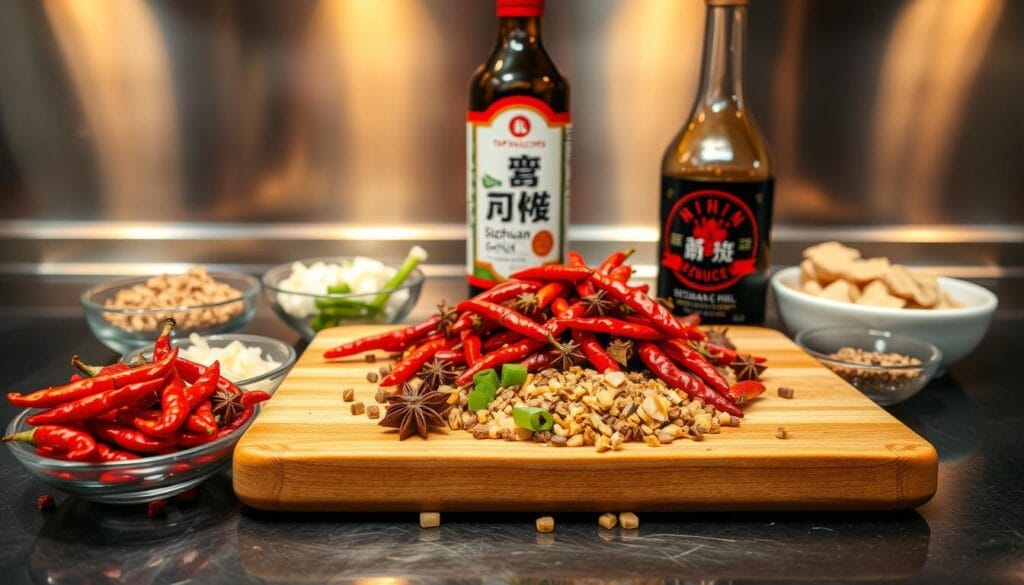
Pairing Szechuan Spicy Beef with Side Dishes
Szechuan spicy beef is just the start. The right side dishes can make your meal complete. When making Szechuan beef Chinese takeout at home, balance the bold flavors and spiciness is key.
Recommended Rice Varieties
The type of rice you choose can change your dining experience with spicy Schezwan beef. Szechuan cuisine often pairs with different rice types. Each offers a unique texture and flavor.
- Jasmine Rice: Its fragrant aroma and soft texture make jasmine rice a favorite for Szechuan dishes.
- Forbidden Black Rice: This rice has a nutty flavor and chewy texture, perfect for Szechuan beef.
- Sticky Rice: Short-grain sticky rice contrasts nicely in texture with the stir-fried beef.
It’s important to cook these rice types right. Jasmine rice should be fluffy, and sticky rice needs the right water to be sticky.
Complementary Dishes
To make a complete meal, pair your Szechuan spicy beef with dishes that balance its heat and intensity.
- Cucumber Salad: A cucumber salad with a light vinaigrette can cool your palate.
- Stir-Fried Greens: Quickly cooked greens like bok choy or Chinese broccoli offer a mild contrast to the spicy beef.
- Clear Soups: A simple clear soup can cleanse your palate between bites of spicy beef.
- Pickled Vegetables: Tangy pickled vegetables can cut through the richness of the beef.
Presenting multiple dishes family-style can make your meal look and feel like a real Chinese dining experience. This approach makes the meal more appealing and encourages sharing and interaction.
Serving Suggestions for Szechuan Spicy Beef
Making your Szechuan Spicy Beef a hit is simple. How you present it is key, as it makes the meal better.
Traditional Serving Methods
In Sichuan, this dish is shared in big dishes. This shows the importance of eating together. Use Chinese plates or bowls to make it look and taste better.
- Use communal serving dishes to encourage sharing.
- Opt for traditional Chinese ceramics to elevate the dining experience.
- Pay attention to portioning to ensure a balanced serving.
Plating Ideas to Impress Guests
There are many ways to plate your Szechuan Spicy Beef. For a simple look, put it in a big dish. For something fancy, add garnishes to make it stand out.
Key Garnishes for Szechuan Spicy Beef:
- Thinly sliced scallions for a pop of color and freshness.
- Toasted sesame seeds to add texture and nuttiness.
- Fresh herbs like cilantro or basil for a fragrant finish.
For crispy Szechuan beef, plate it carefully. This keeps it crispy and looks great. Add garnishes just before serving for the best look and taste.
By following these tips, your authentic Szechuan beef recipe will wow your guests. It will look and taste amazing.
Nutritional Profile of Szechuan Spicy Beef
Exploring the nutrition of Szechuan spicy beef shows its health perks. Knowing its nutritional details adds to its appeal.
Caloric Content Breakdown
The calories in Szechuan spicy beef change with the recipe and cooking. A typical serving has 400 to 700 calories.
This dish has a mix of nutrients. Beef provides protein, while sauce and veggies add carbs. Cooking oil contributes fats.
| Nutrient | Amount per Serving | % Daily Value |
|---|---|---|
| Calories | 550 | 28% |
| Protein | 35g | 70% |
| Fat | 30g | 46% |
| Carbohydrates | 30g | 10% |
Nutritional Benefits of Ingredients
The ingredients in Szechuan spicy beef are nutritious. Beef is packed with protein, vital for muscles.
Sichuan peppercorns and chili peppers add flavor and antioxidants. They also boost metabolism.
Vegetables like bell peppers and broccoli add fiber and vitamins. They make the dish more nutritious.
Understanding Szechuan spicy beef’s nutrition lets you enjoy it healthily. It’s great for a balanced diet.
Szechuan Spicy Beef Variations to Try
Making Szechuan spicy beef your own is simple. Try different proteins and ingredients to match your taste or diet. This makes Szechuan spicy beef a favorite globally.
Alternative Proteins for a Unique Twist
Beef is classic, but you can use other proteins too. Lamb brings a gamey taste, while chicken is leaner. Pork is tender, and game meats like venison or duck offer a bold twist.
Changing proteins means adjusting cooking times and flavors. Chicken cooks quicker than beef, so watch it closely. Lamb needs stronger spices, while chicken might need a lighter touch.
Vegetarian & Vegan Adaptations
For plant-based diets, use seitan, tempeh, or textured vegetable protein. Mushrooms, like king oyster and shiitake, can replace beef in texture and taste.
For vegetarian and vegan versions, keep the marinating and cooking methods similar. Use plant-based sauces and adjust spice levels. Make sure the dish is balanced in protein and umami flavor.
Exploring Authentic Szechuan Restaurants
Looking for the perfect Szechuan Spicy Beef? Food lovers often search beyond their kitchens for authentic Szechuan eateries. Knowing what to look for in a restaurant is key for an authentic Szechuan dining experience.
Finding Top-Rated Szechuan Restaurants
To find the best Szechuan restaurants, start with food blogs and forums. Chinese expatriates often share their top picks there. Review sites are also great, filled with feedback from those who’ve tried the real deal.
Some key resources to consider include:
- Online review platforms like Yelp or Google Reviews, where you can filter search results based on ratings and keywords like “Szechuan” or “Sichuan.”
- Food blogs that specialize in Chinese cuisine, which often feature restaurant reviews and recommendations.
- Community forums or social media groups focused on food or Chinese culture, where members share their dining experiences and suggestions.
| Resource | Description | Usefulness |
|---|---|---|
| Yelp | Review site with filters for cuisine and rating | High |
| Food Blogs | Specialized blogs reviewing Chinese restaurants | High |
| Community Forums | Online groups discussing dining experiences | Medium |
Identifying an Authentic Szechuan Experience
When dining at a Szechuan restaurant, look for certain signs. Menu items like mapo tofu, twice-cooked pork, and water-boiled fish are Szechuan staples. They show the restaurant is serving real Szechuan dishes.
The ambiance and who’s there can also tell you a lot. Traditional Szechuan decor and Chinese patrons are good signs. They suggest a genuine culinary experience.
To get traditional dishes, ask your server for recommendations. Ask for “Chinese menu” items for a more authentic meal.
Hosting a Szechuan Dinner Party
Make your Szechuan dinner party unforgettable. It’s a great way to share your love for cooking. You’ll introduce your friends and family to the bold flavors of Szechuan spicy beef.
Planning Your Menu
Plan a balanced menu for your Szechuan dinner party. Start with Szechuan spicy beef as the main dish. Then, add dishes that show off the region’s unique tastes.
Here are some menu ideas:
- Szechuan Spicy Beef as the main course
- Steamed dumplings or potstickers as an appetizer
- Stir-fried vegetables, like broccoli or bell peppers, for color and texture
- Plain steamed rice or fried rice to cool down the palate
- A refreshing cucumber salad or pickled vegetables to cut the richness
For a bigger menu, consider:
- Hot and sour soup or wonton soup as a starter
- Mapo tofu or twice-cooked pork for more variety
- Szechuan-style snacks, like spicy peanuts or fried wontons
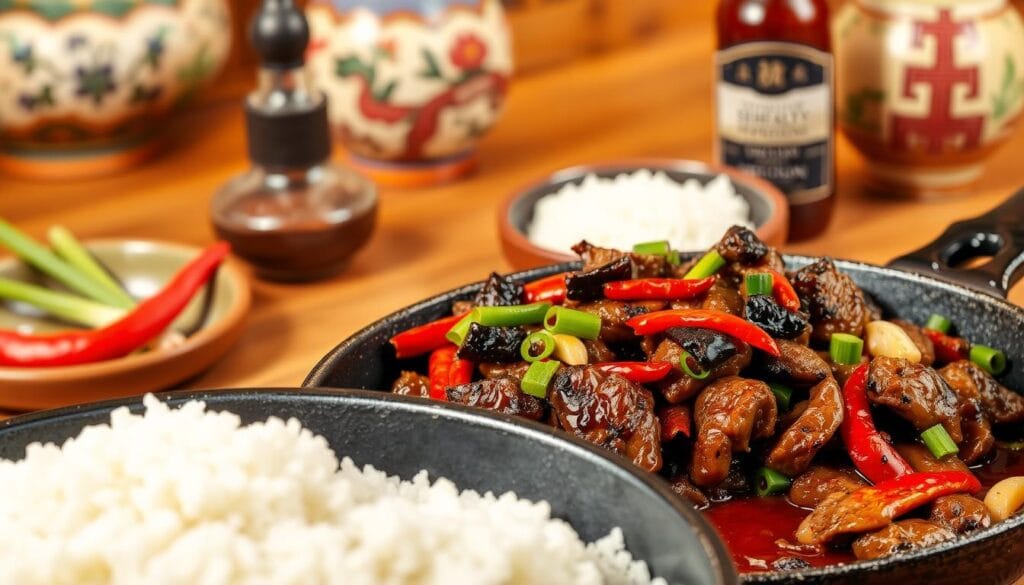
Tips for Creating an Inviting Atmosphere
To create a real Szechuan dining experience, focus on the atmosphere. Start with the table setting. Use round and rectangular tables for communal dining. Add traditional Chinese elements, like:
- Red or gold tablecloths and napkins for good luck
- Simple, elegant ceramic or porcelain dishes
- Chopsticks and spoons as utensils
To enhance the ambiance, play traditional Szechuan music or Chinese instrumental music. Decorate with Szechuan culture elements, such as:
- Traditional Chinese fans or parasols
- Calligraphy or artwork with Szechuan motifs
- Potted plants or vases with flowers, like peonies or plum blossoms
When introducing your guests to Szechuan cuisine, explain the significance of certain dishes. This will deepen their appreciation and make the experience more memorable.
Final Thoughts on Szechuan Spicy Beef
Learning to make Szechuan Spicy Beef is more than just a recipe. It opens up a world of flavors and cooking techniques. This recipe is a key to understanding Chinese regional cooking.
Culinary Exploration Beyond Szechuan Spicy Beef
With your new skills, try other Szechuan dishes like Mapo Tofu or Twice-Cooked Pork. Check out cookbooks by chefs like Fuchsia Dunlop or Grace Young. They can help you learn more about Chinese cooking.
Also, join online cooking forums or communities. Share your cooking stories and learn from others.
Personalizing Your Szechuan Spicy Beef
To make your dish unique, try using local ingredients or change the spice level. While keeping the Szechuan flavor, you can add your own twist. This mix of tradition and creativity is what makes cooking fun.
FAQ
What is Szechuan spicy beef?
What are the key ingredients in Szechuan spicy beef?
How spicy is Szechuan spicy beef?
Can I make Szechuan spicy beef without Sichuan peppercorns?
What is the best cut of beef for Szechuan spicy beef?
How do I tenderize beef for Szechuan spicy beef?
What is the Scoville Scale, and how does it relate to Szechuan spicy beef?
Can I make a vegetarian or vegan version of Szechuan spicy beef?
What are some common side dishes to serve with Szechuan spicy beef?
How do I achieve the signature “breath of the wok” (wok hei) flavor in Szechuan spicy beef?
For more cooking tips, stay connected with us. We also recommend the cookbook Skinnytaste Simple: Easy, Healthy Recipes with 7 Ingredients or Fewer
For more Recipes about Beef?
Did You try our recipe ?
There are no reviews yet. Be the first one to write one.
